WATR07009: Analysis of Water Quality in Irish River Basins
VerifiedAdded on 2023/06/15
|10
|1819
|290
Report
AI Summary
This report provides a detailed analysis of water quality in Irish River Basin Districts, addressing key aspects such as threats to freshwater resources, the definition of Good Surface Water Status according to the Water Framework Directive, and the significance of water bodies in this context. It covers thermal stratification in lakes, the water budget equation, and abiotic environmental factors. Furthermore, it discusses protected areas as defined by the Water Framework Directive, water quality classification for rivers, and the differences between Artificial Water Bodies (AWB) and Highly Modified Water Bodies (HMWB). The report also outlines the hydrological cycle, main river systems in Ireland, actions from the River Basin Management Plan, and bodies involved in its second cycle. A comparison of natural and urban water cycles is presented, along with an explanation of Sustainable Drainage Systems (SuDS) and soft engineering strategies for flood management. Desklib offers a range of study tools and resources for students.
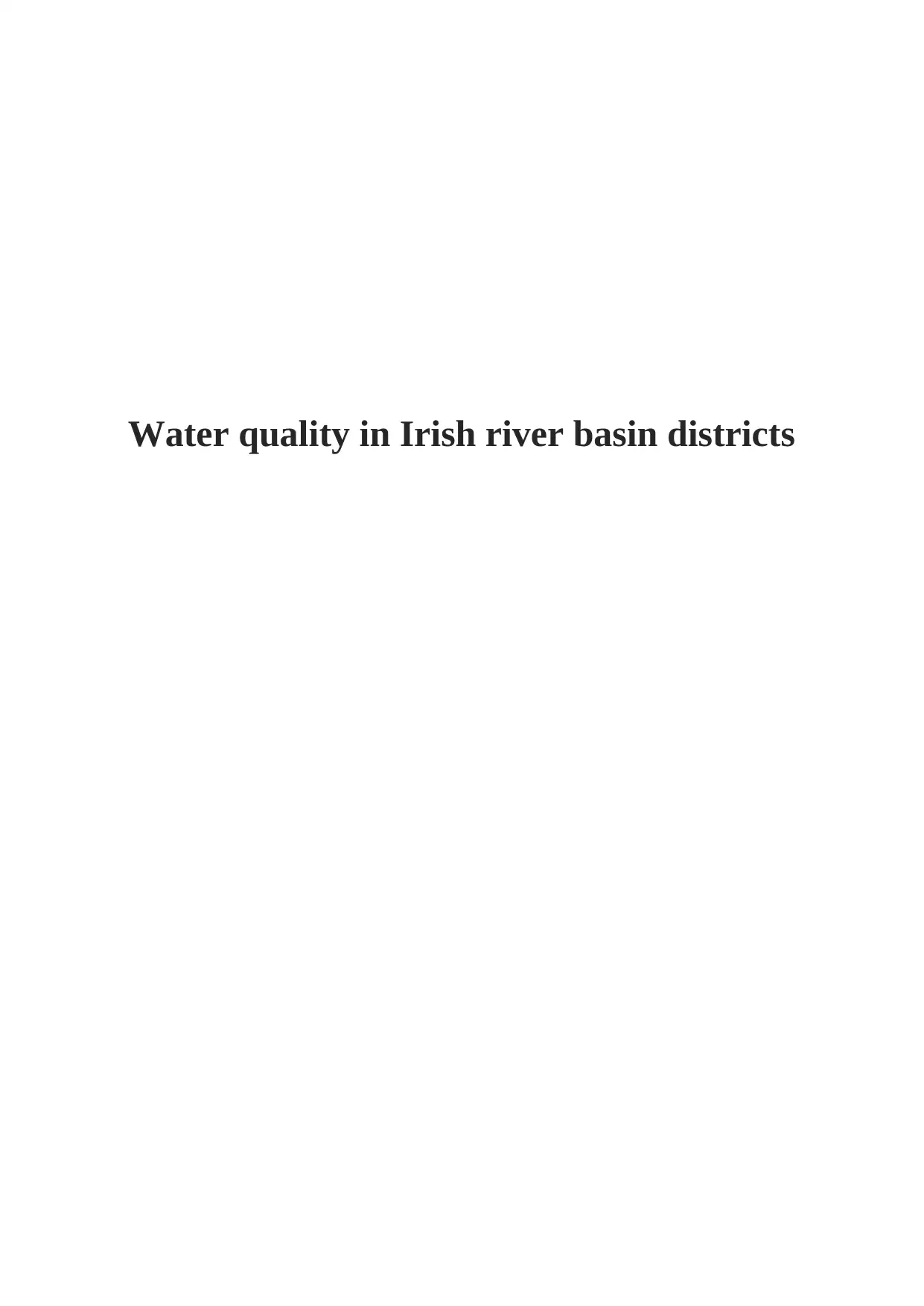
Water quality in Irish river basin districts
Paraphrase This Document
Need a fresh take? Get an instant paraphrase of this document with our AI Paraphraser
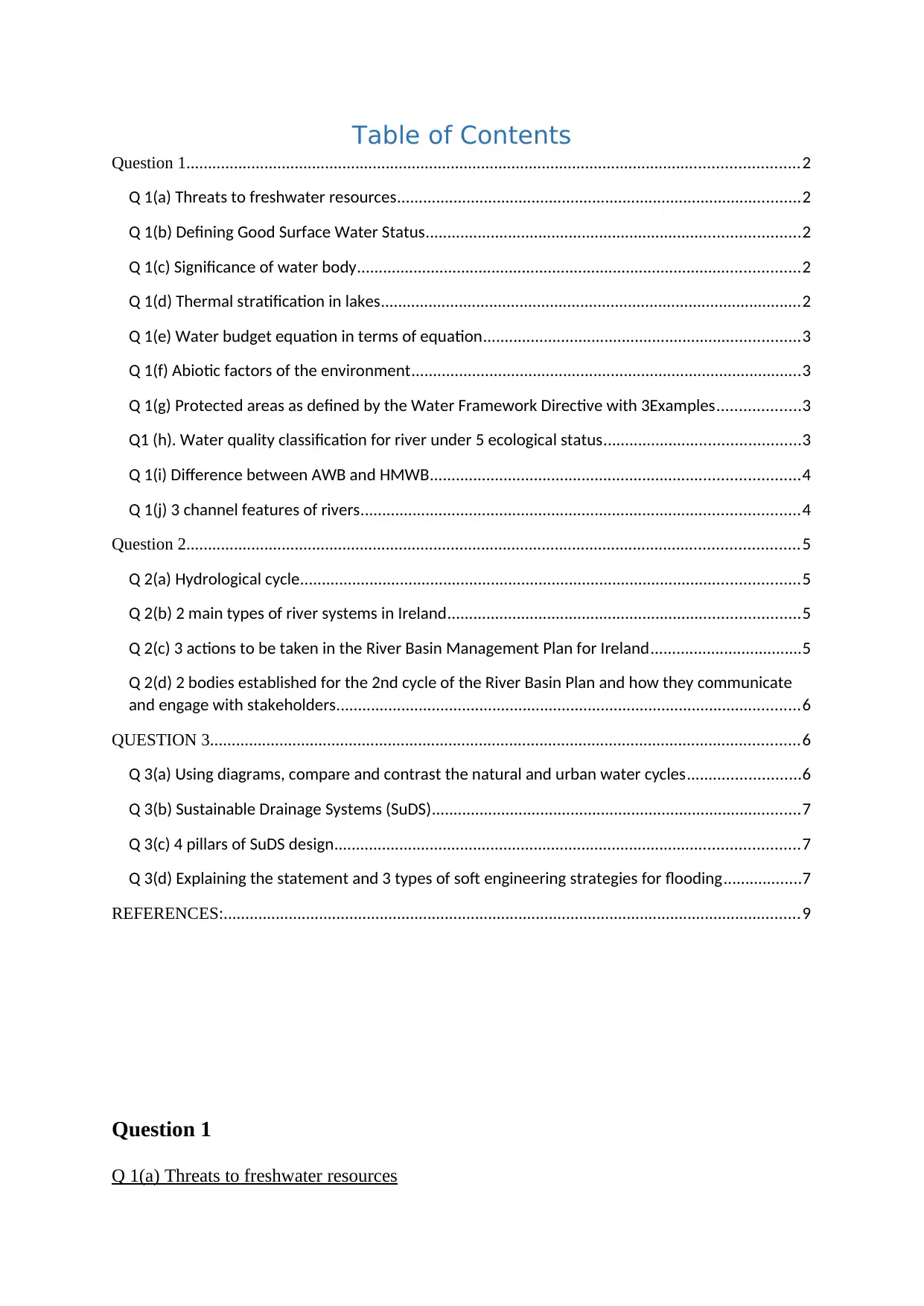
Table of Contents
Question 1.............................................................................................................................................2
Q 1(a) Threats to freshwater resources.............................................................................................2
Q 1(b) Defining Good Surface Water Status......................................................................................2
Q 1(c) Significance of water body......................................................................................................2
Q 1(d) Thermal stratification in lakes.................................................................................................2
Q 1(e) Water budget equation in terms of equation.........................................................................3
Q 1(f) Abiotic factors of the environment..........................................................................................3
Q 1(g) Protected areas as defined by the Water Framework Directive with 3Examples...................3
Q1 (h). Water quality classification for river under 5 ecological status.............................................3
Q 1(i) Difference between AWB and HMWB.....................................................................................4
Q 1(j) 3 channel features of rivers.....................................................................................................4
Question 2.............................................................................................................................................5
Q 2(a) Hydrological cycle...................................................................................................................5
Q 2(b) 2 main types of river systems in Ireland.................................................................................5
Q 2(c) 3 actions to be taken in the River Basin Management Plan for Ireland...................................5
Q 2(d) 2 bodies established for the 2nd cycle of the River Basin Plan and how they communicate
and engage with stakeholders...........................................................................................................6
QUESTION 3........................................................................................................................................6
Q 3(a) Using diagrams, compare and contrast the natural and urban water cycles..........................6
Q 3(b) Sustainable Drainage Systems (SuDS).....................................................................................7
Q 3(c) 4 pillars of SuDS design...........................................................................................................7
Q 3(d) Explaining the statement and 3 types of soft engineering strategies for flooding..................7
REFERENCES:.....................................................................................................................................9
Question 1
Q 1(a) Threats to freshwater resources
Question 1.............................................................................................................................................2
Q 1(a) Threats to freshwater resources.............................................................................................2
Q 1(b) Defining Good Surface Water Status......................................................................................2
Q 1(c) Significance of water body......................................................................................................2
Q 1(d) Thermal stratification in lakes.................................................................................................2
Q 1(e) Water budget equation in terms of equation.........................................................................3
Q 1(f) Abiotic factors of the environment..........................................................................................3
Q 1(g) Protected areas as defined by the Water Framework Directive with 3Examples...................3
Q1 (h). Water quality classification for river under 5 ecological status.............................................3
Q 1(i) Difference between AWB and HMWB.....................................................................................4
Q 1(j) 3 channel features of rivers.....................................................................................................4
Question 2.............................................................................................................................................5
Q 2(a) Hydrological cycle...................................................................................................................5
Q 2(b) 2 main types of river systems in Ireland.................................................................................5
Q 2(c) 3 actions to be taken in the River Basin Management Plan for Ireland...................................5
Q 2(d) 2 bodies established for the 2nd cycle of the River Basin Plan and how they communicate
and engage with stakeholders...........................................................................................................6
QUESTION 3........................................................................................................................................6
Q 3(a) Using diagrams, compare and contrast the natural and urban water cycles..........................6
Q 3(b) Sustainable Drainage Systems (SuDS).....................................................................................7
Q 3(c) 4 pillars of SuDS design...........................................................................................................7
Q 3(d) Explaining the statement and 3 types of soft engineering strategies for flooding..................7
REFERENCES:.....................................................................................................................................9
Question 1
Q 1(a) Threats to freshwater resources
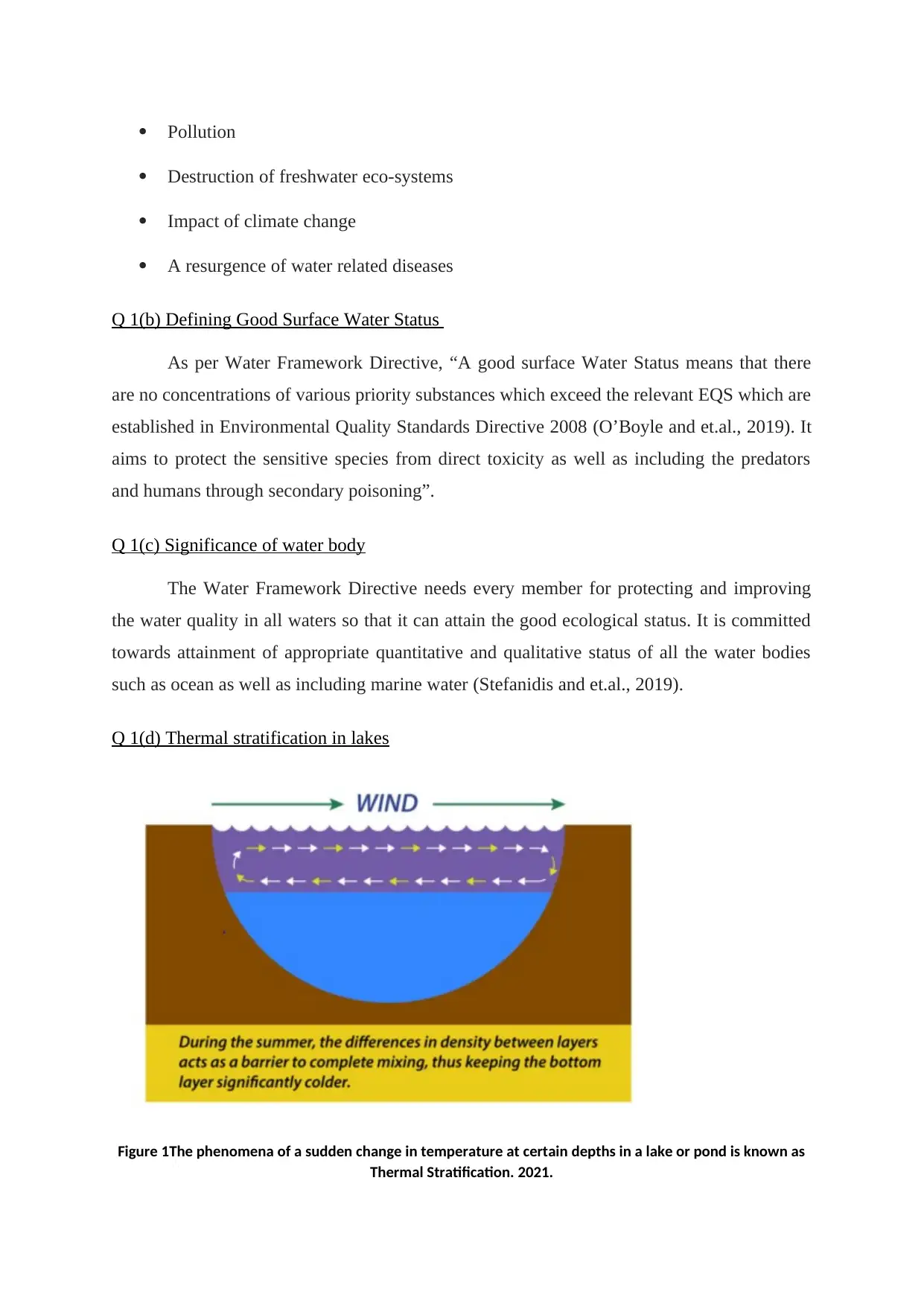
Pollution
Destruction of freshwater eco-systems
Impact of climate change
A resurgence of water related diseases
Q 1(b) Defining Good Surface Water Status
As per Water Framework Directive, “A good surface Water Status means that there
are no concentrations of various priority substances which exceed the relevant EQS which are
established in Environmental Quality Standards Directive 2008 (O’Boyle and et.al., 2019). It
aims to protect the sensitive species from direct toxicity as well as including the predators
and humans through secondary poisoning”.
Q 1(c) Significance of water body
The Water Framework Directive needs every member for protecting and improving
the water quality in all waters so that it can attain the good ecological status. It is committed
towards attainment of appropriate quantitative and qualitative status of all the water bodies
such as ocean as well as including marine water (Stefanidis and et.al., 2019).
Q 1(d) Thermal stratification in lakes
Figure 1The phenomena of a sudden change in temperature at certain depths in a lake or pond is known as
Thermal Stratification. 2021.
Destruction of freshwater eco-systems
Impact of climate change
A resurgence of water related diseases
Q 1(b) Defining Good Surface Water Status
As per Water Framework Directive, “A good surface Water Status means that there
are no concentrations of various priority substances which exceed the relevant EQS which are
established in Environmental Quality Standards Directive 2008 (O’Boyle and et.al., 2019). It
aims to protect the sensitive species from direct toxicity as well as including the predators
and humans through secondary poisoning”.
Q 1(c) Significance of water body
The Water Framework Directive needs every member for protecting and improving
the water quality in all waters so that it can attain the good ecological status. It is committed
towards attainment of appropriate quantitative and qualitative status of all the water bodies
such as ocean as well as including marine water (Stefanidis and et.al., 2019).
Q 1(d) Thermal stratification in lakes
Figure 1The phenomena of a sudden change in temperature at certain depths in a lake or pond is known as
Thermal Stratification. 2021.
⊘ This is a preview!⊘
Do you want full access?
Subscribe today to unlock all pages.

Trusted by 1+ million students worldwide
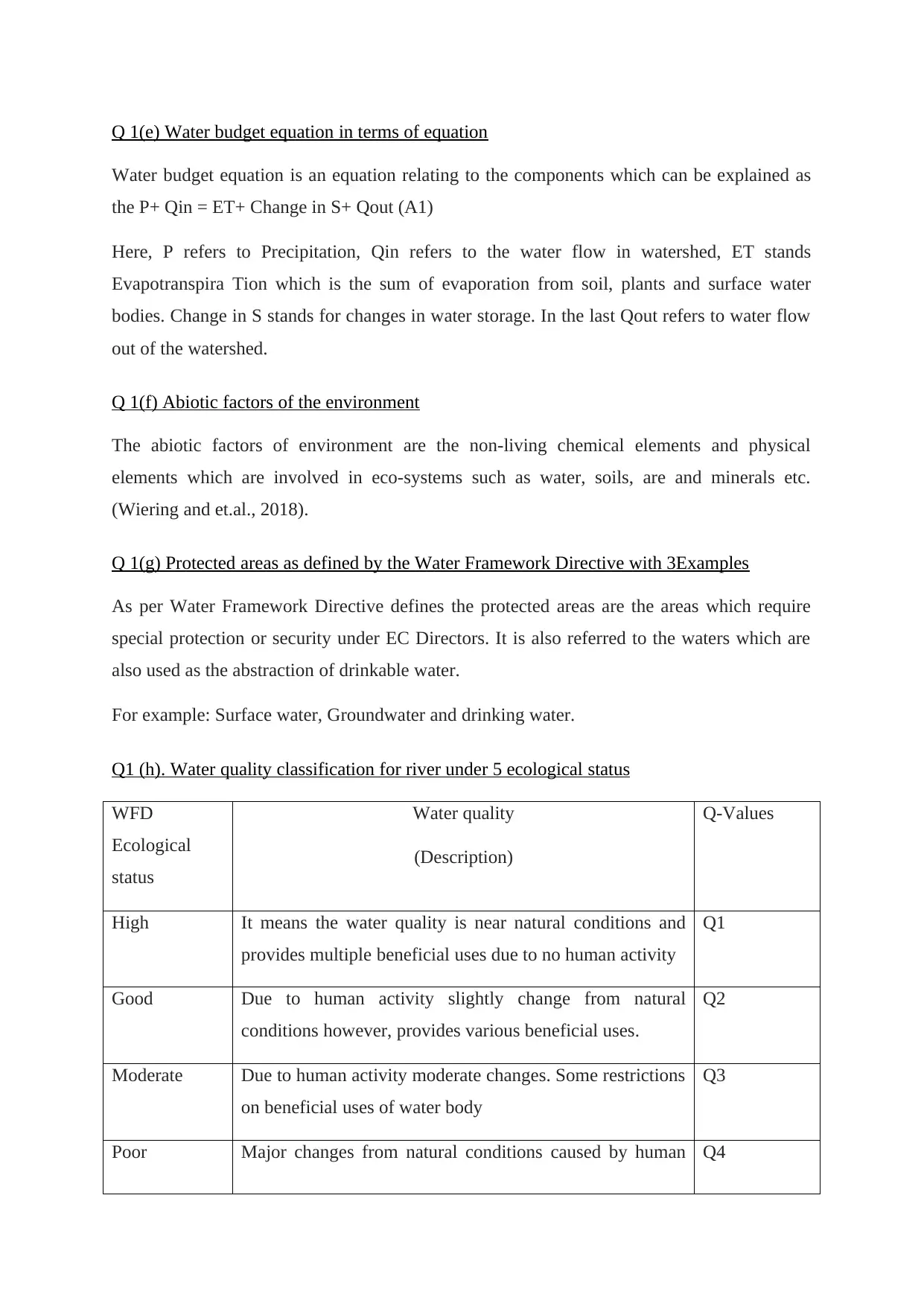
Q 1(e) Water budget equation in terms of equation
Water budget equation is an equation relating to the components which can be explained as
the P+ Qin = ET+ Change in S+ Qout (A1)
Here, P refers to Precipitation, Qin refers to the water flow in watershed, ET stands
Evapotranspira Tion which is the sum of evaporation from soil, plants and surface water
bodies. Change in S stands for changes in water storage. In the last Qout refers to water flow
out of the watershed.
Q 1(f) Abiotic factors of the environment
The abiotic factors of environment are the non-living chemical elements and physical
elements which are involved in eco-systems such as water, soils, are and minerals etc.
(Wiering and et.al., 2018).
Q 1(g) Protected areas as defined by the Water Framework Directive with 3Examples
As per Water Framework Directive defines the protected areas are the areas which require
special protection or security under EC Directors. It is also referred to the waters which are
also used as the abstraction of drinkable water.
For example: Surface water, Groundwater and drinking water.
Q1 (h). Water quality classification for river under 5 ecological status
WFD
Ecological
status
Water quality
(Description)
Q-Values
High It means the water quality is near natural conditions and
provides multiple beneficial uses due to no human activity
Q1
Good Due to human activity slightly change from natural
conditions however, provides various beneficial uses.
Q2
Moderate Due to human activity moderate changes. Some restrictions
on beneficial uses of water body
Q3
Poor Major changes from natural conditions caused by human Q4
Water budget equation is an equation relating to the components which can be explained as
the P+ Qin = ET+ Change in S+ Qout (A1)
Here, P refers to Precipitation, Qin refers to the water flow in watershed, ET stands
Evapotranspira Tion which is the sum of evaporation from soil, plants and surface water
bodies. Change in S stands for changes in water storage. In the last Qout refers to water flow
out of the watershed.
Q 1(f) Abiotic factors of the environment
The abiotic factors of environment are the non-living chemical elements and physical
elements which are involved in eco-systems such as water, soils, are and minerals etc.
(Wiering and et.al., 2018).
Q 1(g) Protected areas as defined by the Water Framework Directive with 3Examples
As per Water Framework Directive defines the protected areas are the areas which require
special protection or security under EC Directors. It is also referred to the waters which are
also used as the abstraction of drinkable water.
For example: Surface water, Groundwater and drinking water.
Q1 (h). Water quality classification for river under 5 ecological status
WFD
Ecological
status
Water quality
(Description)
Q-Values
High It means the water quality is near natural conditions and
provides multiple beneficial uses due to no human activity
Q1
Good Due to human activity slightly change from natural
conditions however, provides various beneficial uses.
Q2
Moderate Due to human activity moderate changes. Some restrictions
on beneficial uses of water body
Q3
Poor Major changes from natural conditions caused by human Q4
Paraphrase This Document
Need a fresh take? Get an instant paraphrase of this document with our AI Paraphraser
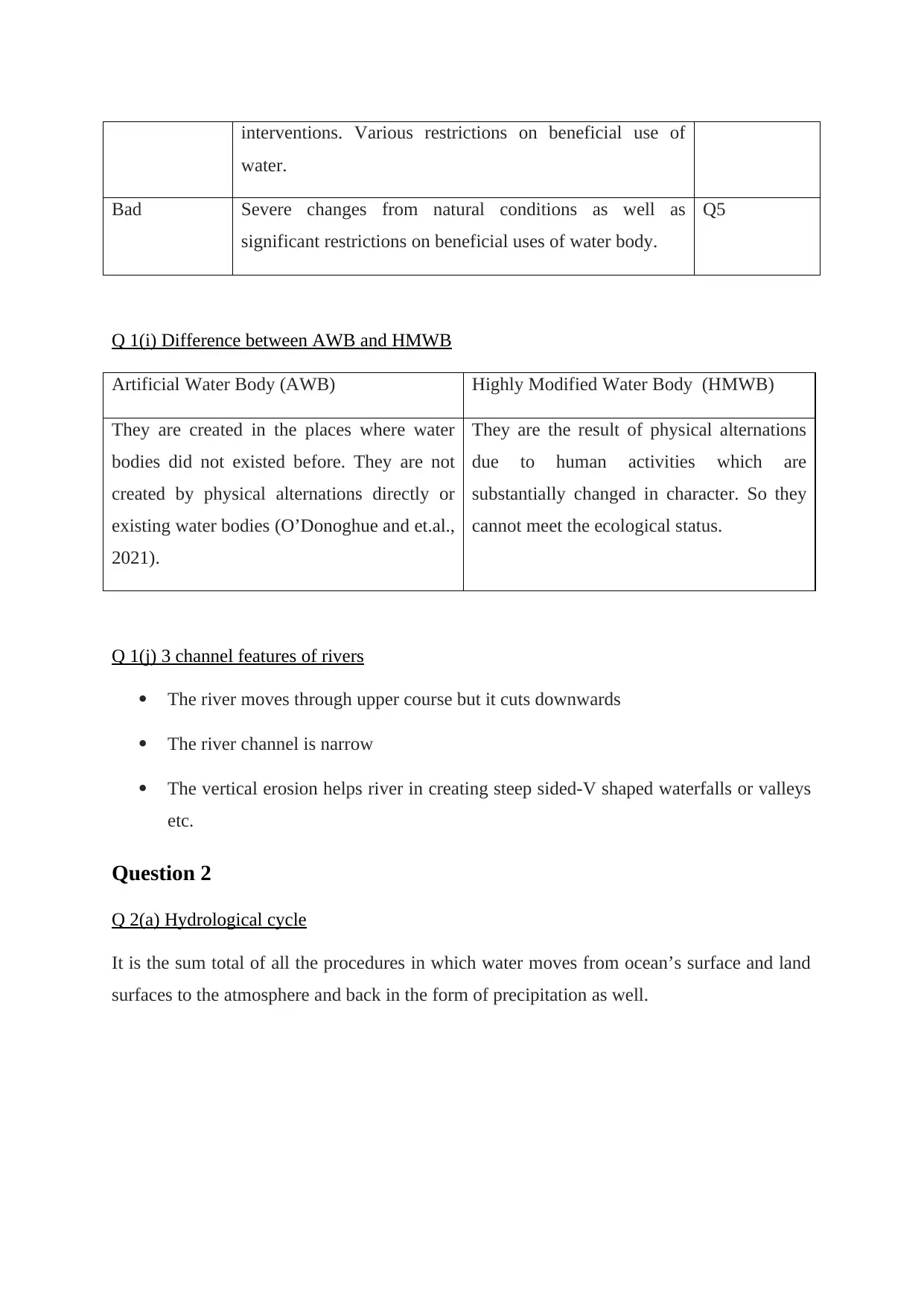
interventions. Various restrictions on beneficial use of
water.
Bad Severe changes from natural conditions as well as
significant restrictions on beneficial uses of water body.
Q5
Q 1(i) Difference between AWB and HMWB
Artificial Water Body (AWB) Highly Modified Water Body (HMWB)
They are created in the places where water
bodies did not existed before. They are not
created by physical alternations directly or
existing water bodies (O’Donoghue and et.al.,
2021).
They are the result of physical alternations
due to human activities which are
substantially changed in character. So they
cannot meet the ecological status.
Q 1(j) 3 channel features of rivers
The river moves through upper course but it cuts downwards
The river channel is narrow
The vertical erosion helps river in creating steep sided-V shaped waterfalls or valleys
etc.
Question 2
Q 2(a) Hydrological cycle
It is the sum total of all the procedures in which water moves from ocean’s surface and land
surfaces to the atmosphere and back in the form of precipitation as well.
water.
Bad Severe changes from natural conditions as well as
significant restrictions on beneficial uses of water body.
Q5
Q 1(i) Difference between AWB and HMWB
Artificial Water Body (AWB) Highly Modified Water Body (HMWB)
They are created in the places where water
bodies did not existed before. They are not
created by physical alternations directly or
existing water bodies (O’Donoghue and et.al.,
2021).
They are the result of physical alternations
due to human activities which are
substantially changed in character. So they
cannot meet the ecological status.
Q 1(j) 3 channel features of rivers
The river moves through upper course but it cuts downwards
The river channel is narrow
The vertical erosion helps river in creating steep sided-V shaped waterfalls or valleys
etc.
Question 2
Q 2(a) Hydrological cycle
It is the sum total of all the procedures in which water moves from ocean’s surface and land
surfaces to the atmosphere and back in the form of precipitation as well.
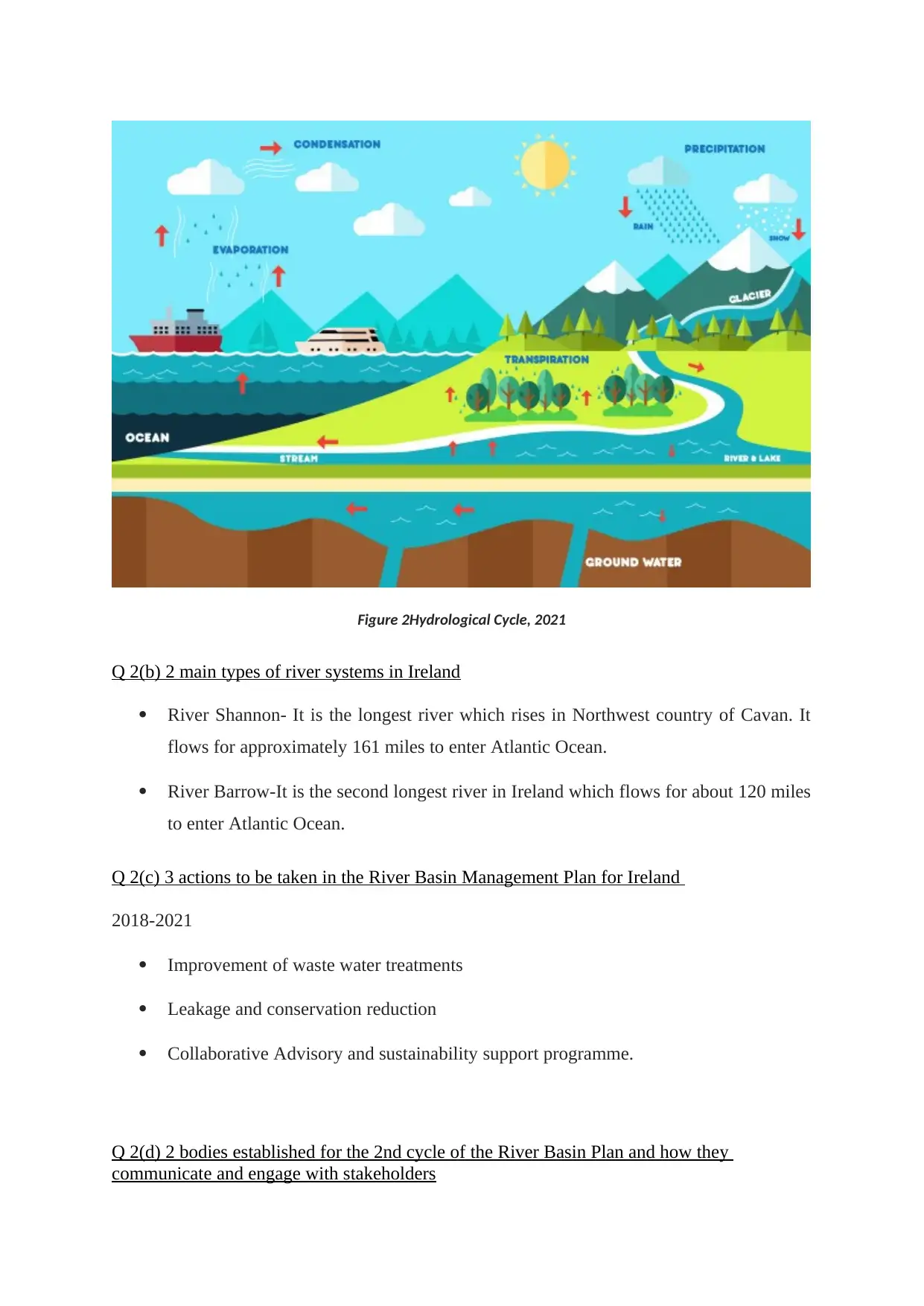
Figure 2Hydrological Cycle, 2021
Q 2(b) 2 main types of river systems in Ireland
River Shannon- It is the longest river which rises in Northwest country of Cavan. It
flows for approximately 161 miles to enter Atlantic Ocean.
River Barrow-It is the second longest river in Ireland which flows for about 120 miles
to enter Atlantic Ocean.
Q 2(c) 3 actions to be taken in the River Basin Management Plan for Ireland
2018-2021
Improvement of waste water treatments
Leakage and conservation reduction
Collaborative Advisory and sustainability support programme.
Q 2(d) 2 bodies established for the 2nd cycle of the River Basin Plan and how they
communicate and engage with stakeholders
Q 2(b) 2 main types of river systems in Ireland
River Shannon- It is the longest river which rises in Northwest country of Cavan. It
flows for approximately 161 miles to enter Atlantic Ocean.
River Barrow-It is the second longest river in Ireland which flows for about 120 miles
to enter Atlantic Ocean.
Q 2(c) 3 actions to be taken in the River Basin Management Plan for Ireland
2018-2021
Improvement of waste water treatments
Leakage and conservation reduction
Collaborative Advisory and sustainability support programme.
Q 2(d) 2 bodies established for the 2nd cycle of the River Basin Plan and how they
communicate and engage with stakeholders
⊘ This is a preview!⊘
Do you want full access?
Subscribe today to unlock all pages.

Trusted by 1+ million students worldwide
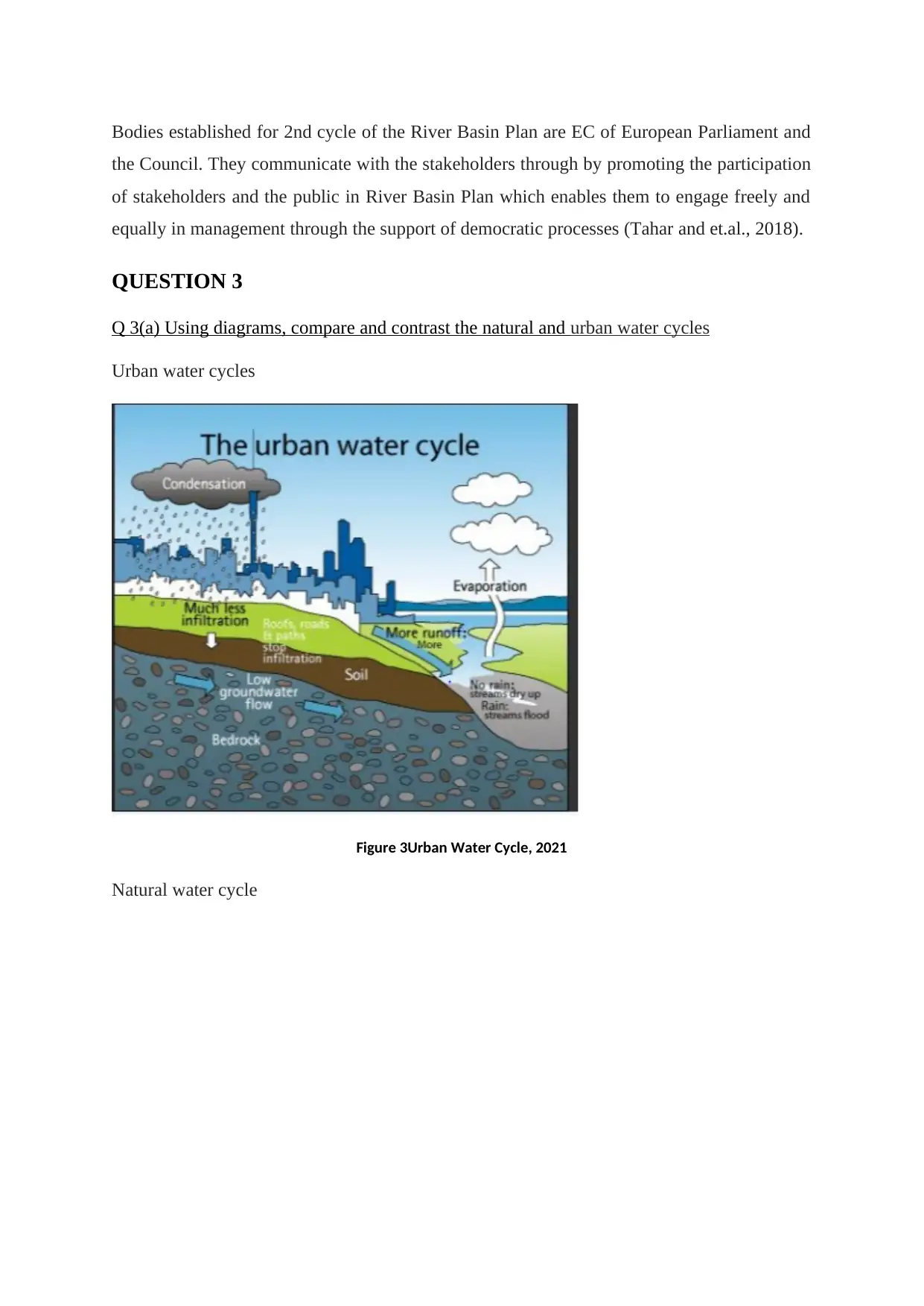
Bodies established for 2nd cycle of the River Basin Plan are EC of European Parliament and
the Council. They communicate with the stakeholders through by promoting the participation
of stakeholders and the public in River Basin Plan which enables them to engage freely and
equally in management through the support of democratic processes (Tahar and et.al., 2018).
QUESTION 3
Q 3(a) Using diagrams, compare and contrast the natural and urban water cycles
Urban water cycles
Figure 3Urban Water Cycle, 2021
Natural water cycle
the Council. They communicate with the stakeholders through by promoting the participation
of stakeholders and the public in River Basin Plan which enables them to engage freely and
equally in management through the support of democratic processes (Tahar and et.al., 2018).
QUESTION 3
Q 3(a) Using diagrams, compare and contrast the natural and urban water cycles
Urban water cycles
Figure 3Urban Water Cycle, 2021
Natural water cycle
Paraphrase This Document
Need a fresh take? Get an instant paraphrase of this document with our AI Paraphraser
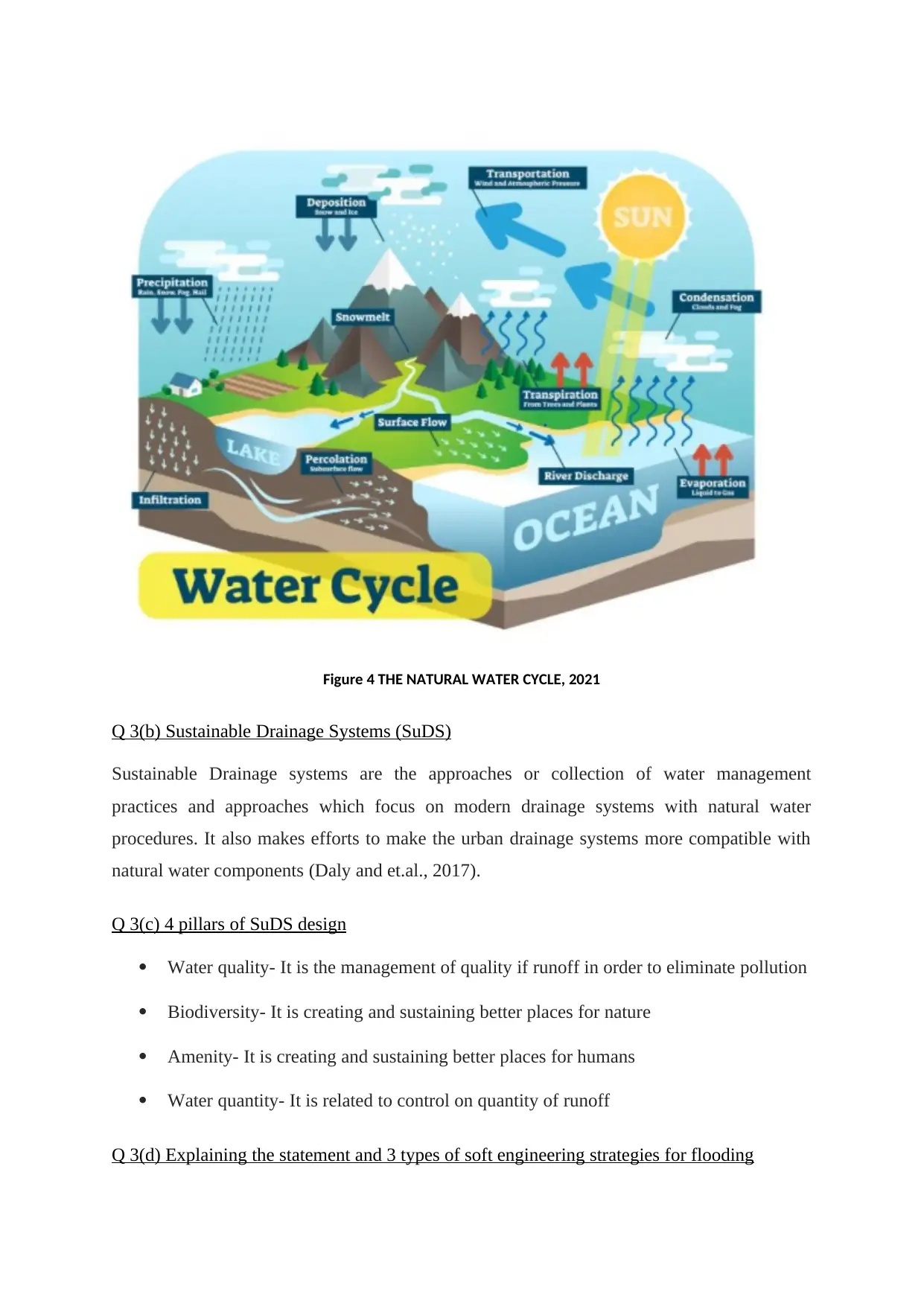
Figure 4 THE NATURAL WATER CYCLE, 2021
Q 3(b) Sustainable Drainage Systems (SuDS)
Sustainable Drainage systems are the approaches or collection of water management
practices and approaches which focus on modern drainage systems with natural water
procedures. It also makes efforts to make the urban drainage systems more compatible with
natural water components (Daly and et.al., 2017).
Q 3(c) 4 pillars of SuDS design
Water quality- It is the management of quality if runoff in order to eliminate pollution
Biodiversity- It is creating and sustaining better places for nature
Amenity- It is creating and sustaining better places for humans
Water quantity- It is related to control on quantity of runoff
Q 3(d) Explaining the statement and 3 types of soft engineering strategies for flooding
Q 3(b) Sustainable Drainage Systems (SuDS)
Sustainable Drainage systems are the approaches or collection of water management
practices and approaches which focus on modern drainage systems with natural water
procedures. It also makes efforts to make the urban drainage systems more compatible with
natural water components (Daly and et.al., 2017).
Q 3(c) 4 pillars of SuDS design
Water quality- It is the management of quality if runoff in order to eliminate pollution
Biodiversity- It is creating and sustaining better places for nature
Amenity- It is creating and sustaining better places for humans
Water quantity- It is related to control on quantity of runoff
Q 3(d) Explaining the statement and 3 types of soft engineering strategies for flooding
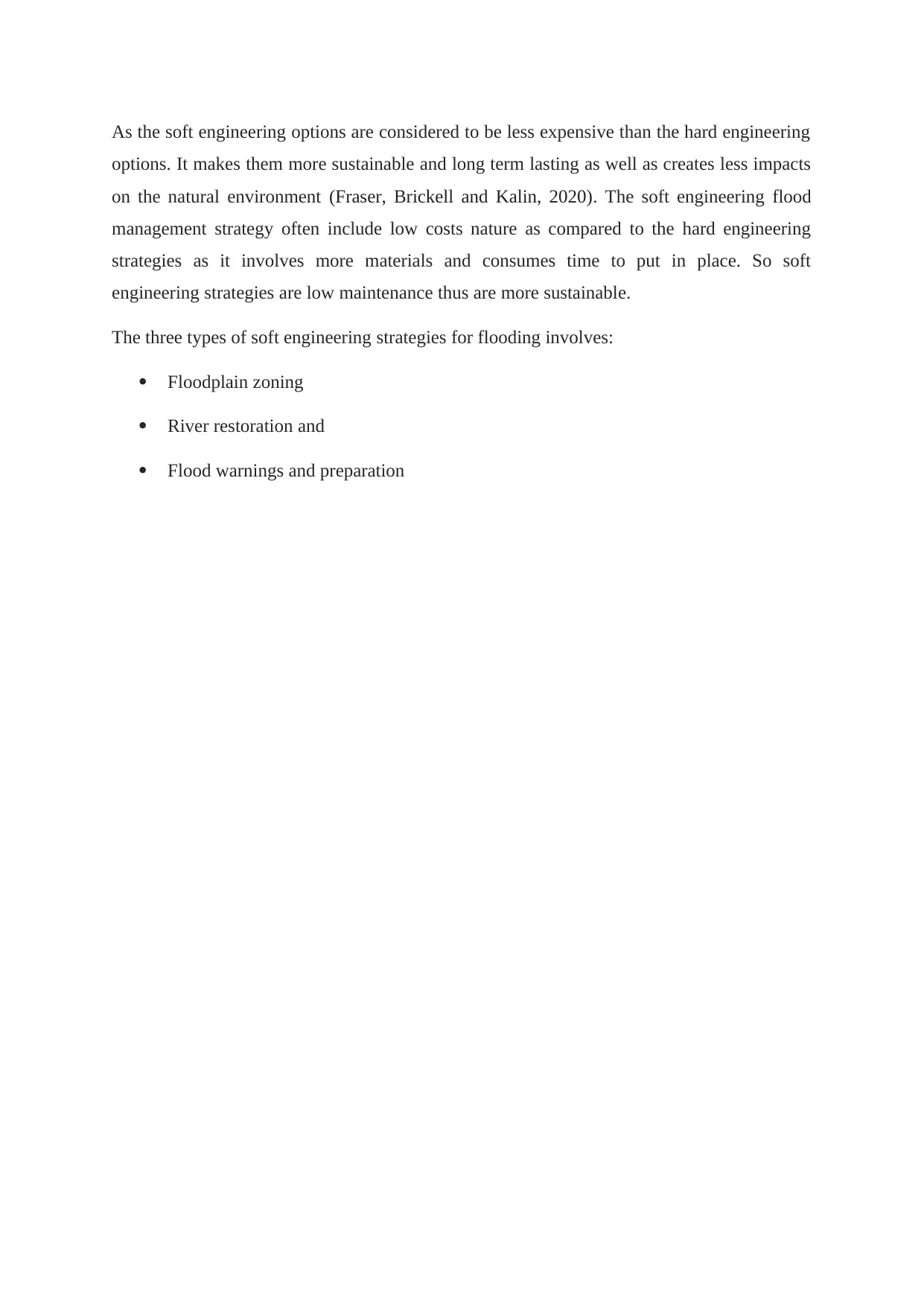
As the soft engineering options are considered to be less expensive than the hard engineering
options. It makes them more sustainable and long term lasting as well as creates less impacts
on the natural environment (Fraser, Brickell and Kalin, 2020). The soft engineering flood
management strategy often include low costs nature as compared to the hard engineering
strategies as it involves more materials and consumes time to put in place. So soft
engineering strategies are low maintenance thus are more sustainable.
The three types of soft engineering strategies for flooding involves:
Floodplain zoning
River restoration and
Flood warnings and preparation
options. It makes them more sustainable and long term lasting as well as creates less impacts
on the natural environment (Fraser, Brickell and Kalin, 2020). The soft engineering flood
management strategy often include low costs nature as compared to the hard engineering
strategies as it involves more materials and consumes time to put in place. So soft
engineering strategies are low maintenance thus are more sustainable.
The three types of soft engineering strategies for flooding involves:
Floodplain zoning
River restoration and
Flood warnings and preparation
⊘ This is a preview!⊘
Do you want full access?
Subscribe today to unlock all pages.

Trusted by 1+ million students worldwide
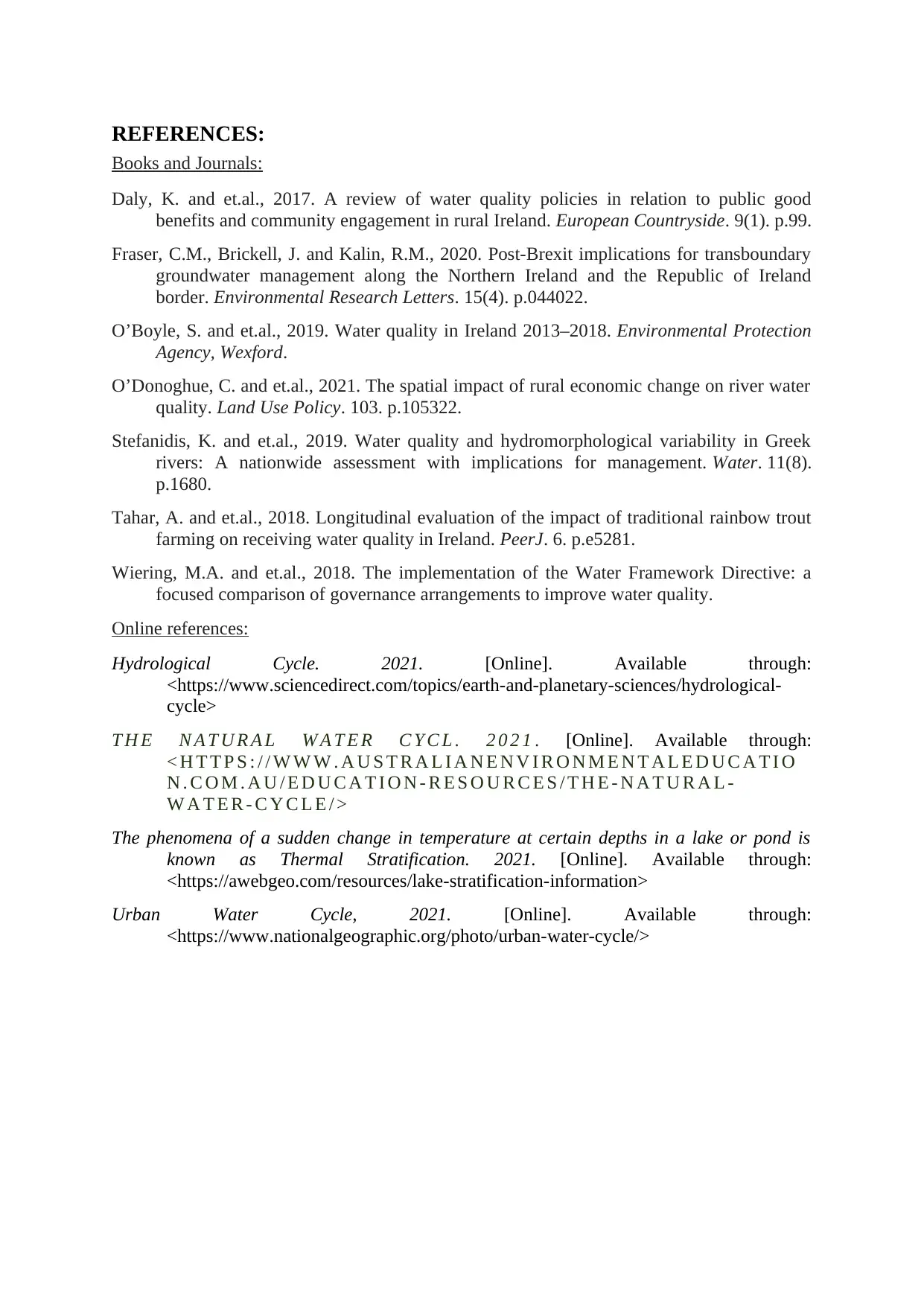
REFERENCES:
Books and Journals:
Daly, K. and et.al., 2017. A review of water quality policies in relation to public good
benefits and community engagement in rural Ireland. European Countryside. 9(1). p.99.
Fraser, C.M., Brickell, J. and Kalin, R.M., 2020. Post-Brexit implications for transboundary
groundwater management along the Northern Ireland and the Republic of Ireland
border. Environmental Research Letters. 15(4). p.044022.
O’Boyle, S. and et.al., 2019. Water quality in Ireland 2013–2018. Environmental Protection
Agency, Wexford.
O’Donoghue, C. and et.al., 2021. The spatial impact of rural economic change on river water
quality. Land Use Policy. 103. p.105322.
Stefanidis, K. and et.al., 2019. Water quality and hydromorphological variability in Greek
rivers: A nationwide assessment with implications for management. Water. 11(8).
p.1680.
Tahar, A. and et.al., 2018. Longitudinal evaluation of the impact of traditional rainbow trout
farming on receiving water quality in Ireland. PeerJ. 6. p.e5281.
Wiering, M.A. and et.al., 2018. The implementation of the Water Framework Directive: a
focused comparison of governance arrangements to improve water quality.
Online references:
Hydrological Cycle. 2021. [Online]. Available through:
<https://www.sciencedirect.com/topics/earth-and-planetary-sciences/hydrological-
cycle>
T H E N A T U R A L W A T E R C Y C L . 2 0 2 1 . [Online]. Available through:
< H T T P S : / / W W W . A U S T R A L I A N E N V I R O N M E N T A L E D U C A T I O
N . C O M . A U / E D U C A T I O N - R E S O U R C E S / T H E - N A T U R A L -
W A T E R - C Y C L E / >
The phenomena of a sudden change in temperature at certain depths in a lake or pond is
known as Thermal Stratification. 2021. [Online]. Available through:
<https://awebgeo.com/resources/lake-stratification-information>
Urban Water Cycle, 2021. [Online]. Available through:
<https://www.nationalgeographic.org/photo/urban-water-cycle/>
Books and Journals:
Daly, K. and et.al., 2017. A review of water quality policies in relation to public good
benefits and community engagement in rural Ireland. European Countryside. 9(1). p.99.
Fraser, C.M., Brickell, J. and Kalin, R.M., 2020. Post-Brexit implications for transboundary
groundwater management along the Northern Ireland and the Republic of Ireland
border. Environmental Research Letters. 15(4). p.044022.
O’Boyle, S. and et.al., 2019. Water quality in Ireland 2013–2018. Environmental Protection
Agency, Wexford.
O’Donoghue, C. and et.al., 2021. The spatial impact of rural economic change on river water
quality. Land Use Policy. 103. p.105322.
Stefanidis, K. and et.al., 2019. Water quality and hydromorphological variability in Greek
rivers: A nationwide assessment with implications for management. Water. 11(8).
p.1680.
Tahar, A. and et.al., 2018. Longitudinal evaluation of the impact of traditional rainbow trout
farming on receiving water quality in Ireland. PeerJ. 6. p.e5281.
Wiering, M.A. and et.al., 2018. The implementation of the Water Framework Directive: a
focused comparison of governance arrangements to improve water quality.
Online references:
Hydrological Cycle. 2021. [Online]. Available through:
<https://www.sciencedirect.com/topics/earth-and-planetary-sciences/hydrological-
cycle>
T H E N A T U R A L W A T E R C Y C L . 2 0 2 1 . [Online]. Available through:
< H T T P S : / / W W W . A U S T R A L I A N E N V I R O N M E N T A L E D U C A T I O
N . C O M . A U / E D U C A T I O N - R E S O U R C E S / T H E - N A T U R A L -
W A T E R - C Y C L E / >
The phenomena of a sudden change in temperature at certain depths in a lake or pond is
known as Thermal Stratification. 2021. [Online]. Available through:
<https://awebgeo.com/resources/lake-stratification-information>
Urban Water Cycle, 2021. [Online]. Available through:
<https://www.nationalgeographic.org/photo/urban-water-cycle/>
1 out of 10
Your All-in-One AI-Powered Toolkit for Academic Success.
+13062052269
info@desklib.com
Available 24*7 on WhatsApp / Email
![[object Object]](/_next/static/media/star-bottom.7253800d.svg)
Unlock your academic potential
Copyright © 2020–2025 A2Z Services. All Rights Reserved. Developed and managed by ZUCOL.


